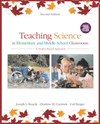 |  Teaching Children Science: A Project-Based Approach, 2/e Joe Krajcik,
University of Michigan - Ann Arbor
Charlene Czerniak,
University of Toledo
Carl Berger,
University of Michigan - Ann Arbor
How is Student Understanding Assessed?
Chapter Summary- The purpose of evaluation is to make judgments about student growth, to set goals, and to report information to students and their parents.
- The process of assessing student understanding might be thought of as a three-step procedure:
- Gathering information that will help in forming generalizations about students' learning.
- Assembling and presenting the information so that it is recorded.
- Evaluating the assessment information.
- Teachers can make formal or informal observations of student progress.
- Discussions can be improved by practicing wait-time, probing, and redirecting.
- Concept maps can be used to assess student's conceptual understandings or the understandings being formulated among groups of students.
- Tests and quizzes can be used to measure students' understanding of content knowledge and process skills.
- Tests and quizzes can be written at low-, medium-, and high-cognitive levels.
- Paper-and-pencil items can use two techniques: selection and supply.
- Selection formats include
- Multiple choice
- True and false
- Matching
- Supply formats include
- Some formats (such as multiple choice and matching) are easy to score and more objective. Other formats (such as essay) take time to answer and grade, and they are open to interpretation.
- Teachers need to take care to write good test/quiz items.
- Good teachers help alleviate test anxiety by teaching well, bringing closure to lessons, reviewing lessons, and practicing sample test items.
- Performance-based assessment refers to methods of directly examining students' knowledge, skills, and dispositions.
- After teachers and students have collected assessment information, they must assemble it into a presentable form for others to see.
- In project-based science, there are two main ways to assemble and present information: artifacts and portfolios.
- Portfolios, collections of student artifacts, can be thought of as both objects and methods of assessment.
- Artifacts include writing samples, daily journals, physical products, drawings, music, videotapes and multimedia documents.
- Artifacts can be used in presentations to groups of younger students, peers, parents, or community members.
- Portfolio assessment is a process of collecting representative samples of students' work over time for purposes of documenting and assessing their learning.
- Typically, four types of documentation are contain in portfolios:
- Artifacts
- Reproductions
- Attestations
- Productions
- The purpose of evaluation is to make judgments about student growth, set goals, and report information to students and their parents.
- A scoring rubric is a brief, written description of different levels of quality for student performance that allows a teacher to rank or rate a level of performance.
- Scoring rubrics can be holistic or analytic.
- There are six steps for creating a rubric:
- Gather and sort student work by quality;
- List the knowledge, skills, or dispositions of an "expert";
- Identify differences between "excellent" and "poor" performance;
- Identify performance levels; and
- Revise criteria as needed.
- After students have selected items to include in the portfolio, it is essential that they reflect upon their progress and overall growth.
- Self-assessment can encourage thinking about learning styles, what was learned, the quality of learning, and personal goal setting.
- In peer assessment, students give feedback to other students in the class. Most students respect the opinions of their peers and value their input.
- Grading is an interpretation or judgment made from data collected and recorded.
- Technology tools have begun to improve the assessment process.
- When assessment is carefully crafted and executed, there are numerous advantages for teacher, students, and parents.
|
|



 2003 McGraw-Hill Higher Education
2003 McGraw-Hill Higher Education